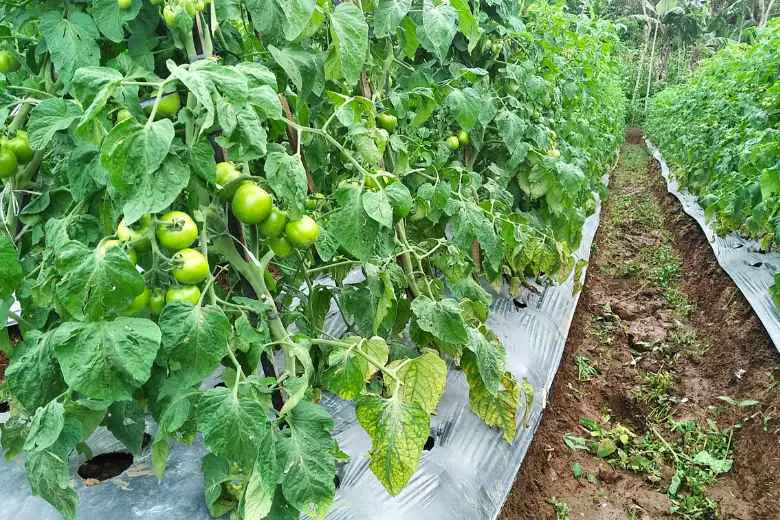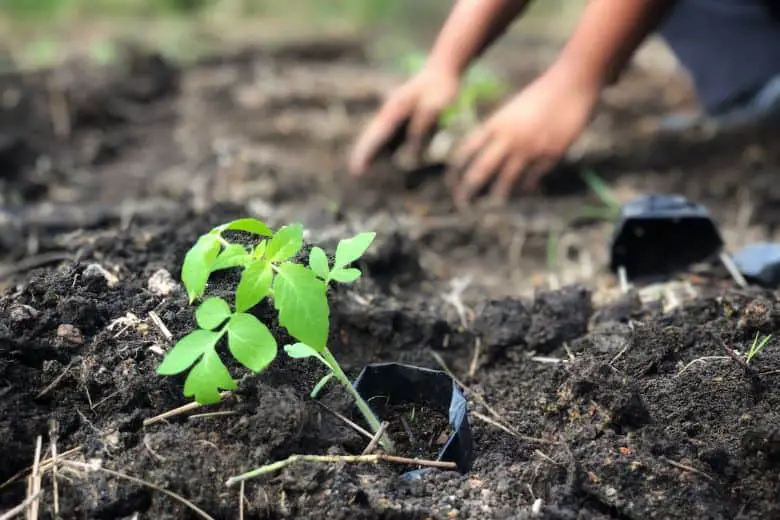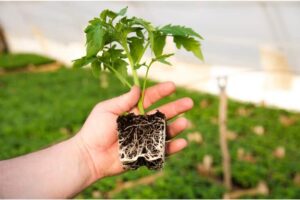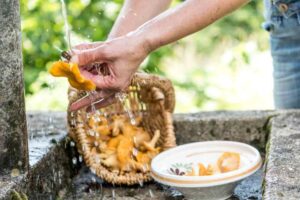
Tomatoes are one of the most widely grown vegetables in home gardens. They are a versatile addition to meals and are enjoyed both cooked and raw. When planning your tomato garden each spring, you may wonder, “Can you plant tomatoes in the same place each year?” or year after year.
Therefore, many gardeners have heard that rotating crops is important, so can tomatoes really stay in one spot?
However, with the proper soil preparation techniques and the use of disease-resistant varieties, it is certainly possible to successfully plant tomatoes year after year in the same garden bed or container. The key is taking steps to maintain healthy soil conditions and suppress any pathogen carryover that might impact your tomato plants.
Let’s take a closer look at this common gardening question.
Why Crop Rotation is Recommended
Rotating crops means planting different types of vegetables or plants in a certain area each season rather than leaving the same one there year after year. There are a few key reasons why crop rotation is generally recommended by gardening experts:
- Pest and Disease Management: Certain pests like fungi, bacteria, nematodes, and insects can build up in the soil if the same crop is continuously planted in one area. These pests often only affect specific plant species. Rotating to a different plant type disrupts the pest lifecycles and decreases pest and disease pressure over time.
- Soil Nutrient Depletion: Different vegetables utilize different nutrients from the soil. Planting the same crop year after year can draw out certain nutrients until that soil is depleted. Rotating ensures a variety of nutrient needs are met.
- Improved Soil Structure: Varied plant roots interact with the soil in unique ways. Taproots from one plant may loosen compacted areas, while fibrous roots from another help with aeration. Varied root systems leave the soil in better condition long term.
So, in general, these factors around pest, nutrient, and soil management make crop rotation an important part of sustainable gardening practices. But in the case of tomatoes, the reality may be a bit more flexible.
Can Tomatoes Really Stay in the Same Spot?
While crop rotation is ideal for many reasons, tomatoes are one type of plant that can often tolerate being in the same area of the garden year after year without significant issues in most home gardens and soil conditions. Here are a few key points on planting tomatoes in the same place:
- Tomatoes are not as vulnerable to repeated pest and disease pressure as some other crops. While fungal issues like early blight or insect pests like Tomato Hornworm could occur, rotating may help, but it is not always necessary for tomatoes.
- The high nutrient needs of tomatoes will deplete certain soil minerals more quickly when they stay in one spot. However, adding compost or fertilizer annually can help replenish what the plants utilize from the soil.
- Tomatoes have a more superficial root system compared to deep-rooted plants. So, their impact on year-over-year soil structure is less substantial than a crop like carrots. Tillage or soil amendments can address any compaction.
- Garden size matters – rotating is more crucial in small garden spaces versus larger plots where moving tomatoes a few feet may be sufficient.
- Home gardener success varies more than commercial production. While some rotation is ideal, leaving tomatoes in the same general area year after year likely won’t make or break your crop.
Bottom line:
In most home vegetable garden conditions, planting tomato plants in the same approximate spot or area of the garden for multiple seasons typically does not pose urgent problems if soil fertility and structure are maintained. While rotating locations is recommended long term, not doing so will not automatically spell disaster for your tomato harvest year over year in the typical backyard setting either.
Tips for Planting Repeat Tomatoes

If keeping your tomatoes in roughly the same area is your preference or the best fit for your space limitations, here are some tips to help maximize success:
# Fertilize annually with compost or a complete fertilizer like 5-10-10 applied before planting to replenish nutrients.
# Till or use a broad fork to aerate the soil, especially if compaction is noticed. Mix in organic matter like shredded leaves.
# Rotate specific tomato variety selections to low disease and pest pressures. Replace existing plants with a resistant variety.
# Consider interplanting with other crops like basil, carrots, or marigolds that can support tomato health.
# Practice good sanitation by removing old plants and pruning diseased foliage during and after the season.
# Closely monitor for signs of issues and address promptly with suitable controls.
# Every 3-5 years, let the tomato area sit fallow or plant with a cover crop for a season to disrupt potential cycles further.
# Move plants at least 2 feet between seasons, even if staying in the general tomato bed.
Risks of Planting Tomatoes in the Same Place
Here are some of the key risks of continuously planting tomatoes in the same place each year:
- Disease buildup in the soil: Tomatoes are susceptible to soilborne diseases like fusarium wilt, verticillium wilt, and root-knot nematodes. Planting tomatoes in the same place year after year allows these pathogens to accumulate to high levels in the soil.
- Lack of soil nutrients: Over time, certain soil nutrients may become depleted if the same vegetables are planted without replenishing amendments. Tomatoes are heavy feeders and need good soil fertility.
- Pest pressure increase: Specific insect pests and fungal/bacterial diseases that attack tomatoes can increase rapidly without crop rotation interrupting their life cycles.
- Loss of soil structure: Continuous tilling and lack of organic matter incorporation from rotational cover crops can cause soil compaction and reduce tilth over successive years of tomato monocropping.
- Poor plant performance: Symptoms like stunted growth, wilting, and low yields can occur due to stress from high disease pressure and nutrient deficiencies related to planting only tomatoes.
- Loss of genetic plant diversity: Relying on the same tomato varieties risks a lack of disease resistance over time, reducing crop resilience to changing pathogen populations in the soil.
So, in summary, disease, nutrient, and pest issues, along with deteriorating soil quality, are the major risks associated with not rotating where tomatoes are planted annually.
Preparation for Planting Tomatoes in the Same Place
Planting tomatoes in the same location each year demands diligent preparation to ensure healthy and productive plants. Here are some key steps to take when preparing for such a situation:
Step 1: Timing
Plant tomato seedlings or transplants 1-2 weeks before the last spring frost date listed for your planting zone. This allows them time to produce fruit before fall weather hits.
Step 2: Spacing
Space transplants 2-3 feet apart in rows 3-4 feet apart, adjusting based on a variety of growth habits. Beefsteak types may need more room than bush varieties.
Step 3: Hole Preparation
Dig holes twice as wide and deep as the transplant’s root ball. Loosening roots slightly before planting helps new growth.
Step 4: Planting Depth
Place transplants in the hole so the first set of real leaves sits just above soil level. This is very important for root development.
Step 5: Filling In
Refill the hole with the removed soil, breaking up any clumps for better contact with roots. Gently pack soil around the base.
Step 6: Watering In
Water thoroughly after planting to settle soil around roots and eliminate any air pockets.
Step 7: Staking/Caging
Guide main stems through stakes or cages as plants grow to keep them upright under heavy fruit loads.
Step 8: Mulching
Top off the planting area with 2-3 inches of organic mulch-like straw to retain moisture, suppress weeds, and stabilize soil temperature.
Following these tomato planting steps each spring helps maintain healthy soil structure and conditions for maximum production annually in the same bed or container.
Care and Maintenance for Planting Tomatoes in the Same Place
When planting tomatoes in the same spot year after year, it’s essential to be extra vigilant with your care and maintenance practices to ensure a bountiful harvest.
- Water tomatoes deeply 1-2 times per week, applying 1-2 inches of water per session.
- Fertilize monthly through side dressing with a balanced fertilizer like 5-10-5.
- Monitor for pests like hornworms, spotted wilt virus, and late blight disease. Treat issues promptly.
- The mulch may need replenishing if it breaks down over the summer.
- Prune off lower leaves and branches not developing fruit to improve circulation.
- Deter deer or other foraging animals if they become a problem.
- Pick fruits regularly as they ripen to encourage more production.
- Remove all remaining plant parts after the first frost, disposing of them outside of the garden.
- Consider a fall/winter cover crop or a different spring crop in rotated sections.
- Monitor soil health annually and replant tomatoes in 18-24 months.
Ongoing care through the growing season sustains healthy soil and plants when keeping tomatoes in the same area year-over-year.
Conclusion
So, in summary, while rotating locations is still the ideal long-term practice, most home gardeners can enjoy success planting tomatoes in the same general spot annually if balanced with good soil management, variety selection, and basic sanitation practices. Use these strategies, and your tomatoes should flourish whether planted repeatedly in one spot or rotated throughout the garden. As always, observe your particular growing conditions and be ready to modify practices as needed. With some care, you don’t have to abandon a favored tomato spot from one season to the next.





